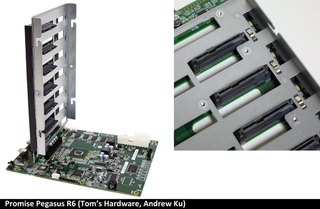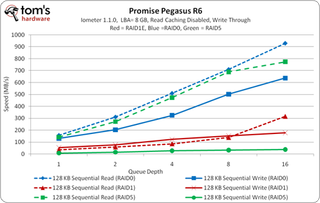Nine External Thunderbolt Storage Devices, Rounded Up
Promise Pegasus R6 12 TB

| Promise | Pegasus R6 6 TB | Pegasus R6 12 TB |
|---|---|---|
| Devices | 6 x 1 TB | 6 x 2 TB |
| Hard Drive | Hitachi 7K1000.D | Hitachi 7K3000 |
| Price (MSRP) | $1799 | $2499 |
Sporting six hot-swappable bays, Promise’s Pegasus R6 is the top dog when it comes to performance-oriented Thunderbolt-based storage solutions. Intel and its partners commonly use this device to demonstrate what the technology is capable of achieving, and the R6's high price makes it even more exclusive. The entry-level 6 TB (6 x 1 TB) model will set you back $1800, and the 12 TB version commands a $2500 price tag.
You get what you pay for, though, and the Pegasus R6 demonstrates its suitability in business-class environments with a serial port for uninterruptible power supply support at the back of the chassis.

Promise sent us its 12 TB Pegasus R6, employing six 2 TB Hitachi 72K300 hard drives (the 6 TB variant is equipped with Hitachi’s 7K1000.D series). The drive bays are well-designed, featuring sturdy aluminum face plates and large release buttons that make it easy to swap storage out in the event of a disk failure.

The picture above, turned upside-down for better clarity, shows the interior of the Pegasus R6, where we find a 250 W power supply driving a motherboard with PMC-Sierra’s PM8011 PCIe SAS 6Gb/s RAID controller. The PM8011 is actually an eight-lane controller. But because Thunderbolt only enables a PCIe x4 uplink, the other four lanes aren't used.
It's interesting that Promise populates the SAS controller with SATA-based hard drives, though not entirely surprising given the premium SAS-capable disks would have added. You can look at the daughtercard's connectors, though, and see the full SAS interface that accommodates SATA disks, too. SAS 6Gb/s and SATA 6Gb/s both enable similar data rates, so there's no concern over compromised performance. We think that Promise's decision to arm its enclosure with SATA storage was the right one. However, should the company wish to offer a version of its R6 with nearline SAS drives in the future, that could become a possibility.
The R6 supports RAID 0, 1E, 5, 6, 10, and 50. However, we're narrowing our focus to the three configurations we feel are most attractive on a device like this: RAID 0, RAID 1E, and RAID 5.

The R6 really stretches its legs when we measure sequential read performance in RAID 0. It falls just 50 MB/s short of the 1 GB/s barrier at a queue depth of 16! If redundancy is more important to you than blistering speed, RAID 1E operates effectively as three RAID 1 arrays, which is why sequential read performance falls to ~315 MB/s. RAID 5 is a fair compromise, enabling block-level striping with distributed parity. We see sequential reads top out around ~780 MB/s in that arrangement.
Stay on the Cutting Edge
Join the experts who read Tom's Hardware for the inside track on enthusiast PC tech news — and have for over 25 years. We'll send breaking news and in-depth reviews of CPUs, GPUs, AI, maker hardware and more straight to your inbox.
This is the only device we're reviewing with performance characteristics that look a little different under OS X than Windows, and there's a reason why. Originally, Thunderbolt allowed device I/O and display signaling to share bandwidth over both bi-directional channels. However, in the summer of 2011, Apple and Intel decided to put device I/O on its own channel in order to preserve the display's signal integrity under heavy workloads.
Prior to that, we were able to achieve close to 920 MB/s in RAID 0 on our 15” MacBook Pro. However, since we "upgraded" to a 13.3” MBP, our new results seem to suggest a ceiling around ~800 MB/s. Promise tells us it sees slightly better performance on PCs, but the delta should only be a few percent at most. Our numbers require more Mac-specific testing, since we don’t know whether it was the update or our system to blame.
-
acku Reply9535164 said:No benchmark for 8-drive Thunderbolt deivces such as Areca ARC-8050 ?
What the R6 isn't expensive enough? :p Honestly, we couldn't include the ARC-8050 (http://www.areca.com.tw/products/thunderbolt.htm) because it's not readily available for purchase (yet).
Cheers,
Andrew Ku
TomsHardware.com -
mayankleoboy1 storage is OK, but an externally powered GPU is the most interesting application of thunderbolt.Reply
with the external PCI-E device specification coming soon, i believe the days of thunderbolt are limited. -
web2dot0 mayankleoboy1storage is OK, but an externally powered GPU is the most interesting application of thunderbolt.with the external PCI-E device specification coming soon, i believe the days of thunderbolt are limited.Reply
Thunderbolt IS ePCI-E. Well, using Intel's implementation. You think the specification will somehow make things cheaper? Nope. -
chovav Thank you Andrew for this review, it certainly makes it clear whether you should invest in thunderbolt or not.Reply
Could you maybe do add a random read/write graph comparing GoFlex Desk with USB3 and Thunderbolt?
I was also wondering what the CPU usage is during read/write - is there any impact at all? or does the thunderbolt controller bear all the processing grunt-work?
Thanks again, great article. -
CaedenV web2dot0Thunderbolt IS ePCI-E. Well, using Intel's implementation. You think the specification will somehow make things cheaper? Nope.thunderbolt is a medium that allows for multiple interconnect protocols to be transmitted over the same wire. It can send PCIe, it can send DP, it was supposed to be able to send USB 1/2/3, as well as Ethernet, all over the same wire... but we have not seen that happen over the copper version that was released.Reply
The external PCIe will be cheaper and easier because it will be hosted directly by the mobo chipset, or the CPU by tapping into already existing hardware. Chip makers will not have to add a new and expensive tech to the device, the connection will just siphon off lanes that are already there. And because it is already standardized and cheap technology it will be easier and cheaper to implement. Finally it will be an open standard that multiple manufacturers can adopt. Thunderbolt (as much as I love the idea) is made and operated by Intel, and Intel wants to charge a premium for it. Until there are multiple chip makers who can make it, then it will continue to be too expensive... and when multiple chip makers can make it then Intel will be the only one worth buying (much like their network interfaces) because nobody can do quality like intel, but at least the price will come down. -
mayankleoboy1 ^ like the Marvell SATA controllers.Reply
And thunderbolt is not going optical fibre in the coming years. the cable is too expensive and cant carry much power.
and the fact that apple is using it gives some clues about its price, compatibility, usability and openness.
i remember how TB was promoted : one single wire from your PC to a TB brick. and from that brick you added USB, ethernet, firewire, DP, HDMI. basically it was touted as "1 wire for everything". supposed to be magical, and we all know how that turns out.
-
acku CaedenVthunderbolt is a medium that allows for multiple interconnect protocols to be transmitted over the same wire. It can send PCIe, it can send DP, it was supposed to be able to send USB 1/2/3, as well as Ethernet, all over the same wire... but we have not seen that happen over the copper version that was released.The external PCIe will be cheaper and easier because it will be hosted directly by the mobo chipset, or the CPU by tapping into already existing hardware. Chip makers will not have to add a new and expensive tech to the device, the connection will just siphon off lanes that are already there. And because it is already standardized and cheap technology it will be easier and cheaper to implement. Finally it will be an open standard that multiple manufacturers can adopt. Thunderbolt (as much as I love the idea) is made and operated by Intel, and Intel wants to charge a premium for it. Until there are multiple chip makers who can make it, then it will continue to be too expensive... and when multiple chip makers can make it then Intel will be the only one worth buying (much like their network interfaces) because nobody can do quality like intel, but at least the price will come down.Reply
Read http://www.tomshardware.com/reviews/thunderbolt-performance-z77a-gd80,3205.html Thunderbolt can externalize anything. It just has to have the controller. It is external PCIe. External USB 3.0 and ethernet are possible but unlikely because they are already on the mobo.
From a practical standpoint, external PCIe may cheaper, but it's pointless from a performance standpoint http://en.wikipedia.org/wiki/PCI_Express#External_PCIe_cards. Everything is limited to a PCIe 1.0 x1 connection. The new ExpressCard standard (v2.0) ups bandwidth to slightly more than PCIe 1.0 x2, which still isn't that fast compared to TB (PCIe 2.0 x4 uplink). Plus ExpressCard only lets you connect a single device. It's one and done after that. For a mobile user, Thunderbolt is the way to go. Worse, you can't count on EC to be available. I'm already seeing Ultrabooks with TB. It makes sense because it doesn't require a lot of space. EC requires more space, hence it will be a greater rarity now that TB is out.
It looks expensive now but be patient. TB is something you will want. Many people need to look past the role Apple played. It clearly is a performance oriented technology that opens up a whole new world, especially on the mobile side.
Cheers,
Andrew Ku
Tom's Hardware.com
-
web2dot0 CaedenVthunderbolt is a medium that allows for multiple interconnect protocols to be transmitted over the same wire. It can send PCIe, it can send DP, it was supposed to be able to send USB 1/2/3, as well as Ethernet, all over the same wire... but we have not seen that happen over the copper version that was released.The external PCIe will be cheaper and easier because it will be hosted directly by the mobo chipset, or the CPU by tapping into already existing hardware. Chip makers will not have to add a new and expensive tech to the device, the connection will just siphon off lanes that are already there. And because it is already standardized and cheap technology it will be easier and cheaper to implement. Finally it will be an open standard that multiple manufacturers can adopt. Thunderbolt (as much as I love the idea) is made and operated by Intel, and Intel wants to charge a premium for it. Until there are multiple chip makers who can make it, then it will continue to be too expensive... and when multiple chip makers can make it then Intel will be the only one worth buying (much like their network interfaces) because nobody can do quality like intel, but at least the price will come down.Reply
Thank you for your Wikipedia quote. Everybody can quote from the spec sheet. The trouble is you make it seem like Intel are bunch of morons building a interconnect that nobody uses. That's is plain wrong. Just like SSDs, they will come down in price and next thing you know, you'll be asking yourself why in the world would I not use Thunderbolt. Imagine running a external GPU on your Retina Display MacbookPro when you dock your laptop. There'll be a lineup of people buying that technology at a premium price.
Partnering with Apple is no accident. 2 giant corporations backing the initiative is nothing to sneeze at. Give it a few years, and you'll soon find out the true power of Thunderbolt. USB 3.0 complements Thunderbolt.
Most Popular

